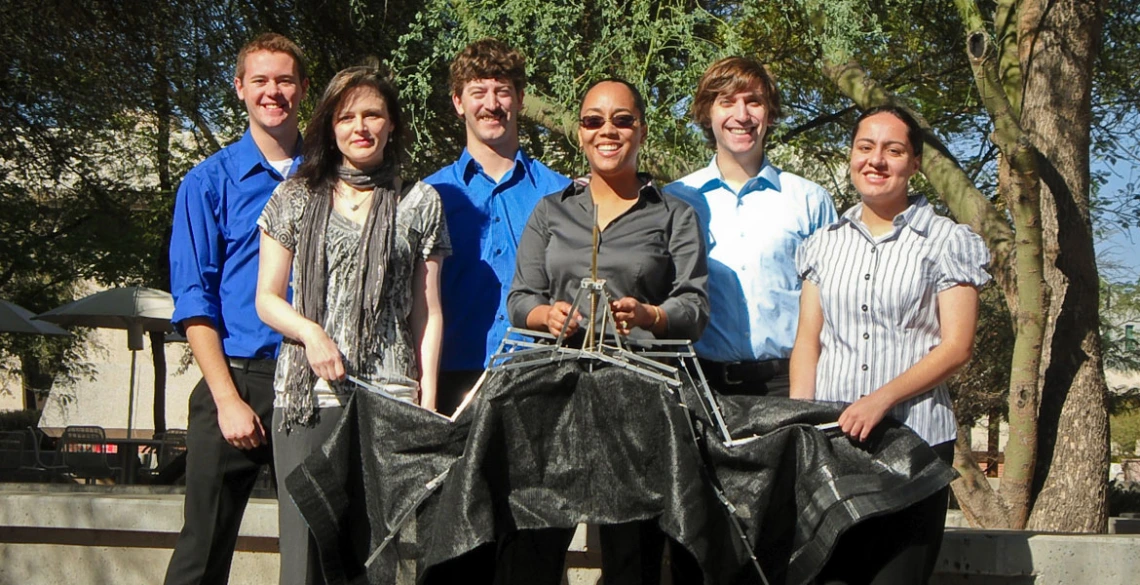Design Day 2010: Innovative Designs by UA Engineering Students Include Mars Lander Camera and Flying Blanket
Engineering students get ready for real-world challenges before they graduate.

The flying blanket design team show their expanding blanket design. Left to right: Colter Ragone, Linda Brackett, Duane Hunt, Karrie Jones, Zach Schloss and Anbar Najam.
A revolutionary new camera for the Mars Lander and a flying blanket that wraps you up and pins you down are just two of the many student engineering projects to be displayed May 4.
These projects are among 60 designed by UA engineering students to be shown at Engineering Design Day, the UA College of Engineering's premier showcase of student design.
Design Day is organized by the College's Interdisciplinary Design Program, Engineering 498, and co-sponsored by Lockheed Martin and BAE Systems as well as the College.
"Engineering 498 is our dry run for students," said Jeff Goldberg, the College's dean. "We give students the real-life experience of doing a project for an external client. The course is really a simulation of that first project."
The event is open to the public, and Goldberg is especially keen to attract middle and high school students to give them a better picture of what engineering is. "It is by far our best advertisement for what engineers do once they get out of college," Goldberg said.
Industry Involvement
Goldberg said that Design Day judges have seen similar events at dozens of other universities, and the feedback from them is that UA's event is by far the strongest.
"What makes our Design Day stronger than so many others are our great industry clients, our instructors, and a lot of really good students who enjoy building a prototype and solving the design problems," Goldberg said.
Seniors in the UA College of Engineering will compete for about $10,000 in prize money during the competition, which is held annually. The students have been working on their projects for two semesters and will present them on May 4 from 10 a.m. to 3 p.m. in the Student Recreation Center at 1400 E. 6th St., Tucson, AZ 85721.
The UA student projects cover a wide range of engineering disciplines related to space exploration and imaging, homeland security, health care, renewable energy, robotics, and more.
Event judges are practicing engineers from companies throughout the country and will review the design presentations and demonstrations. The judges will then compile a list of finalists to be reviewed a second time during the afternoon. The award ceremony will be held at 4 p.m.
Completing a Senior Capstone Project as a team is a graduation requirement for most UA engineering students and the showcase is a chance to present the college's expertise in areas such as biomechanics and sustainable energy.
The senior capstone program gives students experience working on real-world design projects that involve budgets, reviews and deadlines. Many of the projects go on to yield patented commercial products.
The projects are sponsored and funded by student clubs, faculty, and industry partners such as Lockheed Martin, Ventana Medical Systems, BAE Systems, Raytheon, Texas Instruments, Edmund Optics and Honeywell. The companies also sponsor prizes and provide some of the approximately 70 professional engineers who serve as judges.
Selected Projects
Flying Blanket
Raytheon is sponsoring a project to design a flying blanket. The project requires students to design a firing tube that shoots a folded blanket that opens up in mid-air before wrapping around its target. As that target could be human, the objective is to create a nonlethal way of immobilizing and restraining a person. The final design involves a collapsible metal exoskeleton that spreads out like a giant bat wing and then wraps around the target on impact.
Space Suit Air Systems Switching Valve
Paragon Space Development Corporation has sponsored the design of a space suit valve that helps astronauts get rid of carbon dioxide from their space suit ventilation systems. Current space suit breathing systems are inefficient and heavy, and also eject water and oxygen, which pollute the astronauts' environment but in space are still valuable resources that need to be conserved. Paragon is developing a completely new technology to remove carbon dioxide from space suit life support systems, and the company has asked students to design a valve that helps collect and vent carbon dioxide. The finished system will improve energy efficiency, reduce water usage, and reduce environmental contamination in Paragon's Orion spacesuit.
Global Warming in Arizona Based on a 60-Day Test
The Lockheed Martin Advanced Technology Center is sponsoring a project to measure carbon dioxide in the atmosphere. The student design team is building a sensitive solar-powered detection system that will monitor carbon dioxide for 60 days. They will then compare their results with other satellite and terrestrial readings and see what conclusions they can draw about global warming in the Tucson area.
Remote Pulse Oximeter
Texas Instruments is sponsoring a project to design a small oximeter, which measures the amount of oxygen present in the blood. The design specifications call for the oximeter to be small enough and comfortable enough to be worn by a sleeping infant. Novel features of the oximeter will be an alarm that sounds when oxygen levels sink too low, and the ability to wirelessly transmit data to a cell phone or home computer.
NASA RISA Camera Project for Mars Lander
NASA and UA have challenged a team of students to build a better camera for space missions. New NASA spacecraft will have less cargo space than the previous shuttles. NASA's Remote Image System Acquisition, or RISA, project wants to build a versatile imaging system that can be used for many applications, which would decrease the volume of cargo space required. The specifications require the final design to have wireless power and communications, and to be small, light, and energy efficient. It will also have to be very tough. Current space cameras are considered virtually disposable because the radiation and temperature extremes found in space wreak havoc with instrumentation.

